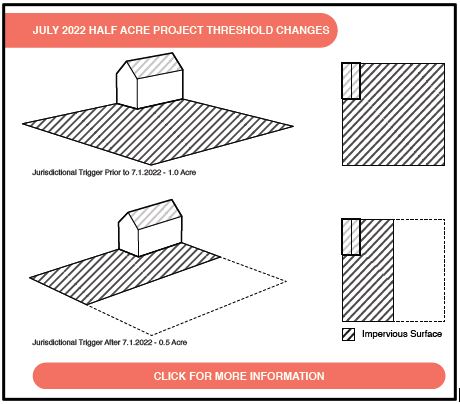General Permit 3-9050 was issued on September 1, 2020 and went into effect on December 1, 2020.
General Permit 3-9050 is a permit for stormwater runoff from impervious surfaces. It is an important component of the Vermont Clean Water Act of 2015 (Act 64) and is designed to assist in the implementation of clean-up efforts in Lake Champlain, Lake Memphremagog, and stormwater-impaired waters, while also protecting high quality surface waters statewide. This general permit covers all operational stormwater permitting, including new development, redevelopment, and permit renewal. Additionally, this general permit serves as the “Three-Acre General Permit” as required under the Vermont Clean Water Act.
Effective July 1, 2022 the operational permitting thresholds for new development and redevelopment change, and development that meets the following thresholds for new development and redevelopment is required to obtain permit coverage under 3-9050:
- A discharge from new development equal to or greater than ½ acre of impervious surface, provided the project does not qualify for one of the transition exemptions in General Permit 3-9050 1.5(F);
- A discharge from the redevelopment of an existing impervious surface if the redeveloped portion of the existing impervious surface is equal to or greater than ½ acre provided the project does not qualify for one of the transition exemptions if General Permit 3-9050 1.5(F)
In General Permit 3-9050(1.7) “new development” is defined as construction of impervious surface on a tract or tracts of land where no impervious surface previously existed. “Redevelopment” is defined in Section 1.7 of 3-9050 as construction or reconstruction of an impervious surface where an impervious surface already exists when such construction involves substantial site grading, substantial subsurface excavation, or substantial modification of an existing stormwater conveyance, such that the total impervious surface to be constructed or reconstructed is greater than the minimum regulatory threshold. The half-acre threshold does not apply to construction of expanded impervious surface on a tract or tracts of land where impervious surface exists. Operational permitting is required for an expansion of existing impervious if there has already been or will be as a result of the expansion a cumulative total of 5,000 square feet of impervious surface constructed since July 4, 2005 and 1 acre or greater of total resulting impervious surface.
Transition Exemptions from Coverage under General Permit 3-9050 1.5(F)
Coverage under General Permit 3-9050 or an Individual Stormwater Discharge Permit is not required for stormwater runoff from the aforementioned ½ acre permitting thresholds, provided one of the following transition exemptions applies:
1. Except for applications for permits issued pursuant to Section 22-107(b)(6) (stormwater discharge construction permits) of the Stormwater Permitting Rule (Environmental Protection Rules, Ch. 22), complete applications for all local, State, and federal permits related to the regulation of land use or a discharge to waters of the State have been submitted as of July 1, 2022, the applicant does not subsequently file an application for a permit amendment that would have an adverse impact on water quality, and substantial construction of the project commences within two years from July 1, 2022;
2. Except for permits issued pursuant to Section 22-107(b)(6) (stormwater discharge construction permits) of the Stormwater Permitting Rule (Environmental Protection Rules, Ch. 22), all local, State, and federal permits related to the regulation of land use or a discharge to waters of the State have been obtained as of July 1, 2022, and substantial construction of the project commences within two years from July 1, 2022;
3. Except for permits issued pursuant to Section 22-107(b)(6) (stormwater discharge construction permits) of the Stormwater Permitting Rule (Environmental Protection Rules, Ch. 22), no local, State, or federal permits related to the regulation of land use or a discharge to waters of the State are required, and substantial construction of the project commences within two years from July 1, 2022; or,
4. The construction, redevelopment, or expansion is a public transportation project, and as of July 1, 2022, the Agency of Transportation or the municipality principally responsible for the project has initiated right-of-way valuation activities or determined that right-of-way acquisition is not necessary, and substantial construction of the project commences within five years from July 1, 2022.

